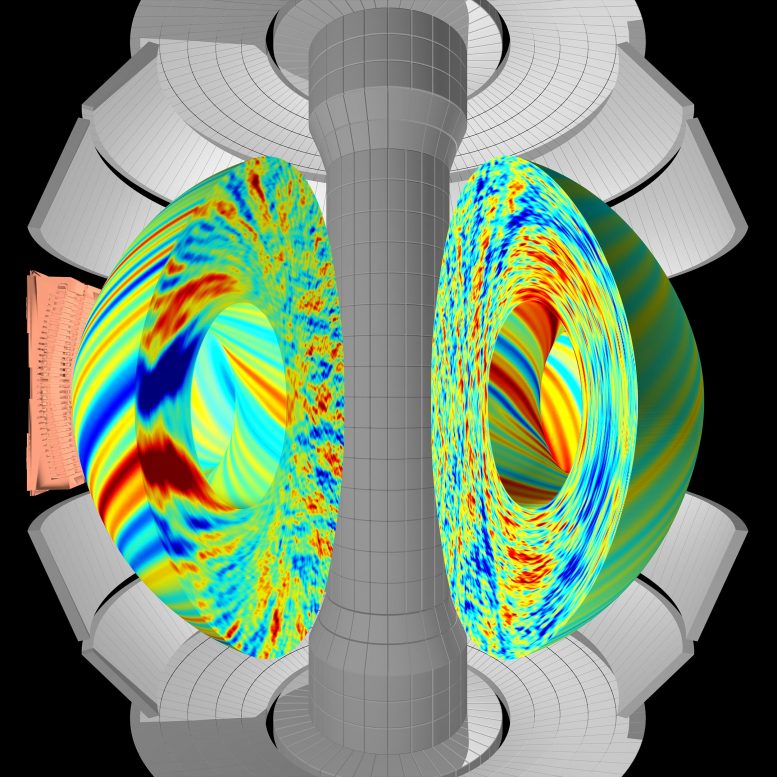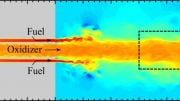
Supercomputer simulation of plasma turbulence in a spherical tokamak. Credit: Image courtesy of Walter Guttenfelder of Princeton Plasma Physics Laboratory
What Is Fusion Energy Science?
Fusion energy science is a multi-disciplinary field focused on the science needed to develop an energy source based on a controlled thermonuclear fusion reaction. Fusion occurs when two nuclei combine to form a new nucleus. This process occurs in our Sun and other stars. Creating conditions for fusion on Earth involves generating and sustaining a plasma. Plasmas are gases that are so hot that electrons are freed from atomic nuclei. Researchers use electric and magnetic fields to control the resulting collection of ions and electrons because they have electrical charges. At sufficiently high temperatures, ions can overcome repulsive electrostatic forces and fuse together. This process—fusion—releases energy.
Fusion Energy Science Quick Facts
- Fusion offers a potential long-term energy source that uses abundant fuel supplies and does not produce greenhouse gases or long-lived radioactive waste.
- Fusion releases energy because the mass of its bound nucleus is less than the mass of it component protons and neutrons; the mass deficit is converted to energy through Einstein’s equation (E=mc2).
- A pickup truck filled with fusion fuel has the equivalent energy of 2 million metric tons of coal, or 10 million barrels of oil.
DOE Office of Science: Fusion Energy Science Contributions
U.S. government support for fusion energy research and development began in the 1950’s at the Atomic Energy Commission, the predecessor to the Department of Energy. Support for fusion continues in the Department of Energy Office of Science, which directs continuing research on the scientific basis for plasma confinement and other fusion-energy-related areas. The DOE fusion energy program helps researchers coordinate across the many fundamental sciences that are involved with fusion, including plasma physics, nuclear engineering, and advanced scientific computing. Scientists can create conditions for fusion with various techniques that use a variety of magnetic, electrical, and other methods to shape and control plasma. For example, magnetic confinement research facilities in the United States and United Kingdom have helped researchers better understand how to sustain fusion reactions and even generate power from them. This progress motivated the international collaboration on the ITER experiment, which aims to build and operate a burning plasma experiment based on a magnetic confinement concept called a tokamak. The U.S. contribution to ITER is managed by the Fusion Energy Sciences (FES) program within the Office of Science. Once built, ITER will be the world’s largest international scientific research facility.
Acknowledgments
Matthew Lanctot, U.S. DOE Office of Science









Was there an article there, I reached the end before I even started!
By 2050 when climate change will hit the sh*t fan, there won’t be a single fusion power plant in operation, they are just pushing impossibly difficult physics and engineering.
If we want zero carbon baseload enegry now we could build Molten salt reactors, these are relatively trivial to build compared with anything like ITER.
At the basic level both types of reactors generate heat at high temperatures, the rest of the project are essentially the same, taking heat away via a coolant loop, storing it and using it for process heat or making electricity. Those parts can be essentially off the shelf.
For a fission reactor, it is only necessary to put fuel into a passive molten salt tubes which sits in a molten salt coolant loop. For fusion, there are endless amounts of technology involving cryomagnetics, superconducting cables, plasmas that need to be contained and stabilized, provision of fuel that doesn’t even exist ie tritium, generating tritium and collecting from lithium fissioning, protecting the vessel chambers. ITER is $20B and going and far from break even. MSR thermal reactors can be built for $B or so depending on size and we have known how to do the basics for 50 years.
Fission reactors can be fundamentally designed by very small teams of scientists and engineers often 1 key scientist. ITER employs many thousands of the same all over the world, nobody can possibly understand the whole project in detail. How could it possibly compete? Just look at all the sub projects that make up ITER and all the companies involved, a failure in any one part esp the magnets holds up the project by years. There are much smaller fusion projects around too some with only a handful of people involved, but we rarely hear about them and their progress is interminably slow.
Elon Musk says not needed and fission reactors are now safe
Too high temperature for fusion. Thermal steady state and alternating stressed too high long term no doubt when reaction lasts more than a second.
There are three more modern new generation nuclear fission reactor types that need the US government to standardize their designs and procure them for power companies. All three are extremely safe going so far as to say as close to meltdown proof as it is probably possible. They are:
(1) Molten Salt Reactors as John Jakson mentioned
(2) Pebble Bed Reactors
(3) Thorium Reactors – similar to MSR reactors, but even safer
No commercial private or public company can and would invest in these reactors, but the ONLY way the world can get off fossil fuels for power generation in the short term is the US government to design, build, and pay for them.
Longer term, fusion power will be necessary, however, Tokamaks have not demonstrated an ability to stabilize plasmas long enough to create net power. In my view, they may never achieve the stability required, as rabbit hole. Dense Plasma Focus devices may be a much more promising alternative. LPPFusion.com has been experimenting and engineering a DPF generator for some time and proceeds slowly due to limited funding.
Some DOE funding should be invested in LPPFusion as a way to insure against the failure of the Tokamaks. It is not wise to put all of our US funding eggs in the Tokamak basket.